The 3D bioprinting market is estimated to be valued at USD 2.95 billion in 2025 and is expected to reach USD 8.53 billion by 2032, growing at a compound annual growth rate (CAGR) of 16.4% from 2025 to 2032.
The 3D bioprinting market is witnessing significant growth due to various factors such as rising application of 3D bioprinting in various industries, increasing funding for R&D in 3D bioprinting, and technological advancements in 3D bioprinting processes and biomaterials.
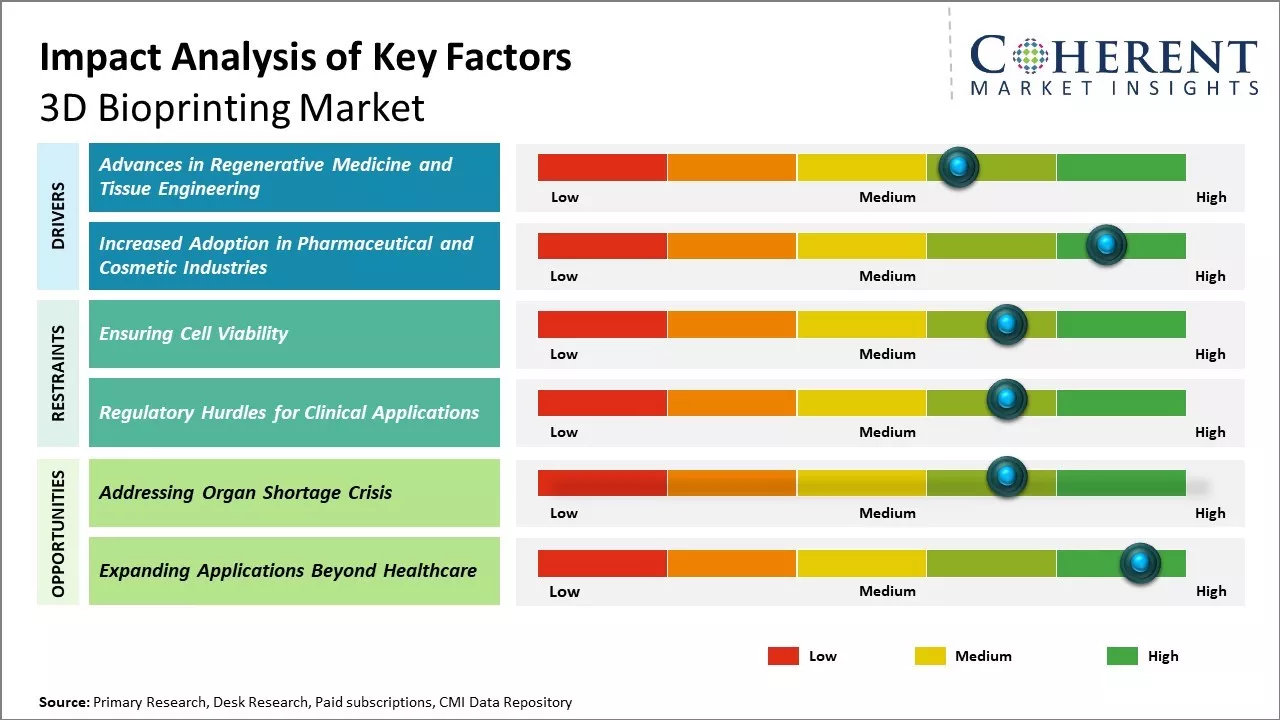
Discover market dynamics shaping the industry: Request sample copy
Some of the major applications driving the market growth include drug testing, organ transplantation, and tissue engineering. Furthermore, the usage of 3D bioprinters for manufacturing personalized tissue and organ replacement parts is also contributing to the market growth. Several key players are actively engaged in new product launches and technological innovations to consolidate their market position in the 3D bioprinting market.
Advances in Regenerative Medicine and Tissue Engineering
3D bioprinting has opened new avenues for advancements in regenerative medicine and tissue engineering. Traditional tissue engineering techniques have limitations in developing complex living tissue constructs that mimic natural tissues. With 3D bioprinting, researchers can bio print tissues and organs layer-by-layer with variable cell types, growth factors and biomaterials to better recapitulate the biological, mechanical and structural properties of natural tissues. Complex 3D printed tissues have been made containing blood vessels which was challenging to achieve earlier. Bioprinting also allows printing of patient-specific tissues with potential for disease modelling and development of personalized treatment options.
For instance, in May 2022, Regemat 3D which is a creator of living tissue technologies, secured over USD 545,000 to advance its 3D bioprinting technology, encompassing software, a bioreactor, materials, and accessories. The firm's portfolio includes the BIO V1 and REG4LIFE 3D bioprinters designed for disease modeling, drug testing, and organ-on-a-chip applications. The BIO V1 offers precise movements in the X, Y, and Z axes, while the REG4LIFE facilitates independent Z-axis movement, enabling the use of two syringes on multi-well plates.
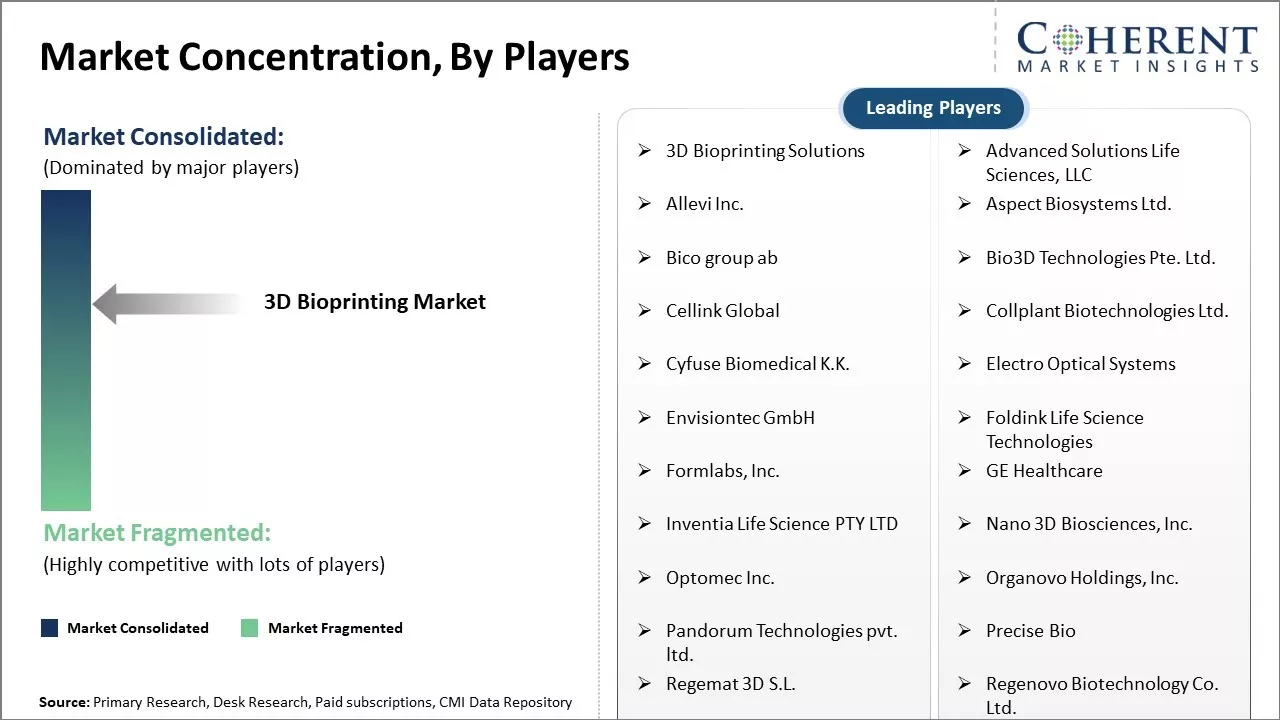
Get actionable strategies to beat competition: Request sample copy
Increased Adoption in the Pharmaceutical and Cosmetic Industries
The burgeoning applications of 3D bioprinting in the pharmaceutical and cosmetic industries is emerging as pivotal drivers for the 3D bioprinting market. In drug discovery, the utilization of 3D bioprinted human tissues facilitates effective compound screening, toxicity analysis, and the development of tissue-based assays. This approach enhances the predictability and reliability of preclinical studies, surpassing the limitations of conventional 2D cell culture models. The pharmaceutical sector is actively embracing bioprinting to expedite the development of new drugs and bio-therapeutics, with a focus on personalized approaches.
The dynamic landscape of the healthcare sector in India, identified as one of the fastest-growing industries, contributes significantly to the 3D bioprinting market's growth. With the sector projected to triple to USD 133.44 billion ( INR 8.6 trillion) by 2022 and India's commitment to increasing public healthcare spending from 1.2% to 2.5% of GDP by 2025, these trends create a favorable environment for the adoption and expansion of 3D bioprinting technologies in the country. This convergence of factors positions the 3D bioprinting market to experience substantial growth, driven by the increasing demand across diverse applications in the pharmaceutical and cosmetic sectors.
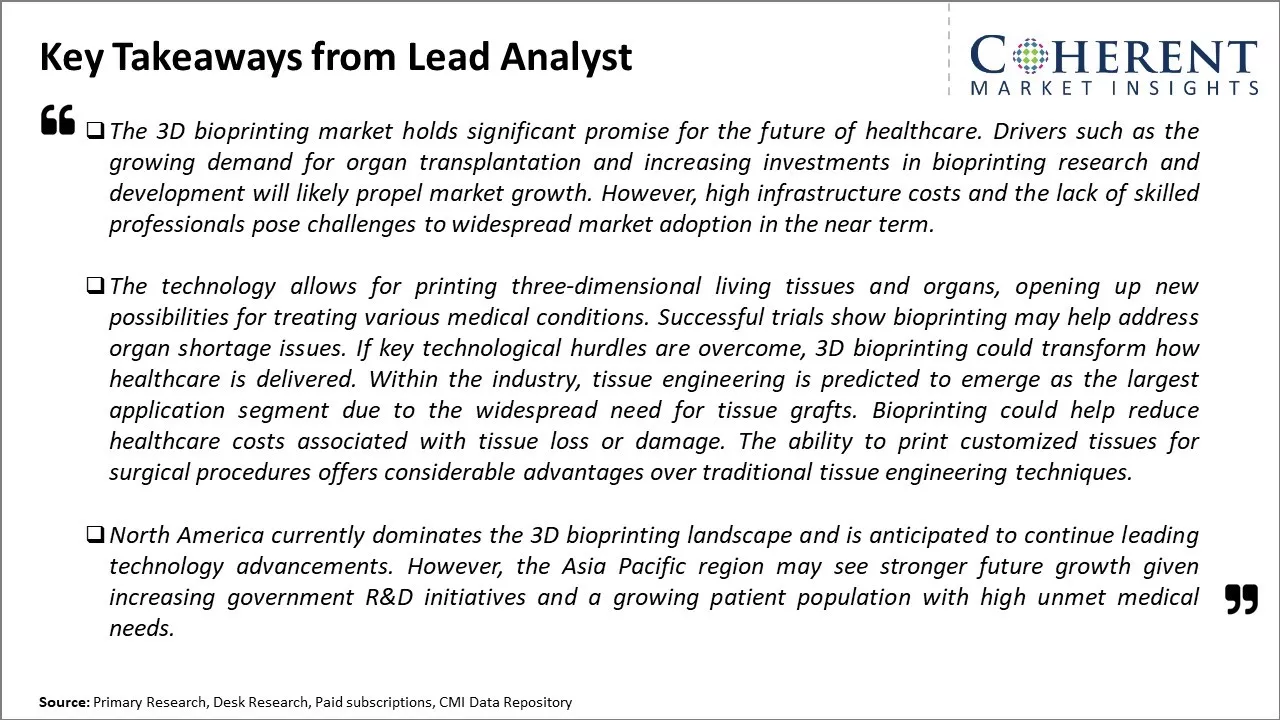
To learn more about this report, Request sample copy
Market Challenges: Ensuring Cell ViabilityThe 3D bioprinting market currently faces several technological challenges. Creating viable living tissues and organs using printing technology is an intricate process that requires mimicking the intricate microstructures found in the human body down to the cellular level. Additional challenges include achieving sufficient cell viability during and after the printing process and resolving issues with material properties support tissue maturation. Regulatory bodies also need to address safety and ethics concerns before printed tissues and organs can be implanted in patients.
Market Opportunities: Addressing Organ Shortage Crisis
The ability to custom design and print living grafts, implants and eventually whole organs on demand could revolutionize transplants and regenerative medicine. It offers potential solutions for replacing damaged tissues and addressing organ shortages. As bioprinting methods advance, opportunities will grow in healthcare, drug testing and cosmetics.
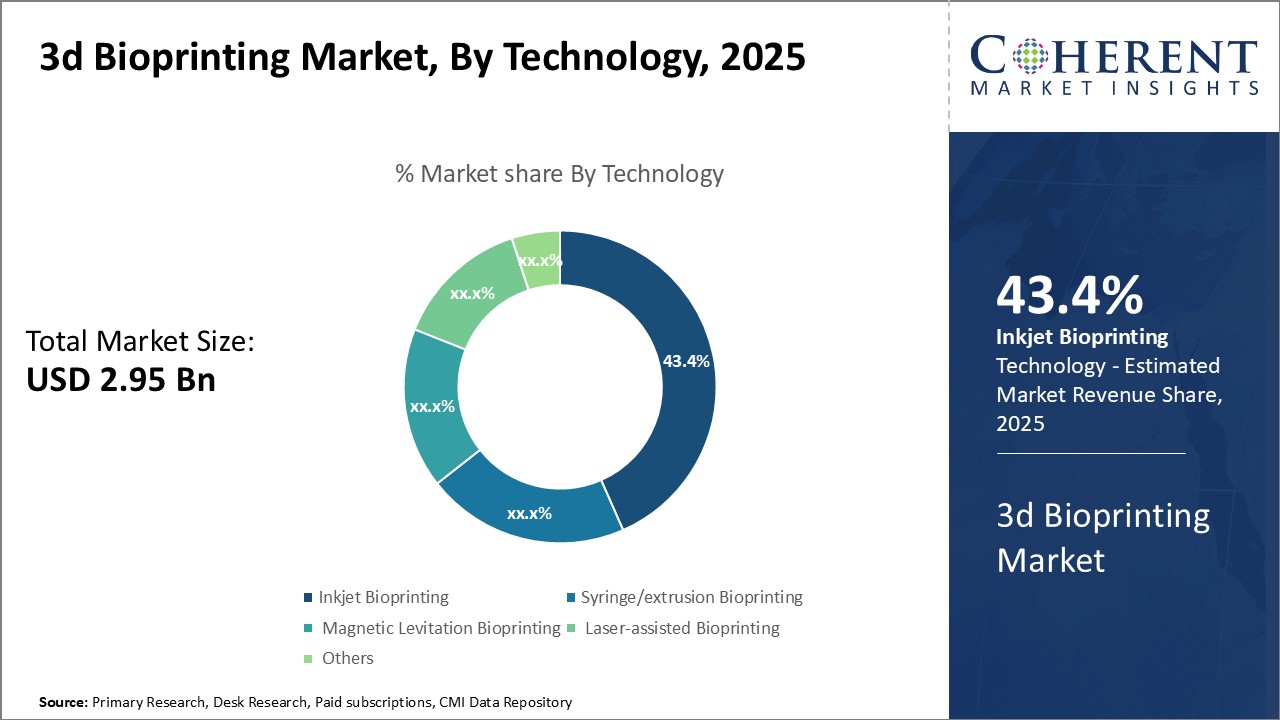
Discover high revenue pocket segments and roadmap to it: Request sample copy
Insights, By Technology- Precision and Multi-Material Print Capabilities Propel Inkjet BioprintingIn terms of technology, inkjet bioprinting is expected to contribute the highest share of 43.4% in 2025, owing to its precise multi-material printing capabilities. Inkjet bioprinting works by ejecting biomaterial droplets through fine nozzles, allowing for precise controlled deposition of differing materials in intricate patterns layer-by-layer. This makes it very well-suited for applications requiring complex tissue structures built from multiple cell or scaffold types. Its non-contact printing process also minimizes damage to fragile cells. Inkjet printers can simultaneously print cells, growth factors, and other biomaterials with high resolution down to the picolitre range. Researchers are able to deposit different bioinks with 10-100 micrometer precision. The multi-material printing ability has enabled new advancements in tissue and organ design.
Insights, By Component- Versatility of Biomaterials Spurs their Dominance
In terms of component, biomaterials is expected to contribute the highest share of 45.48% in 2025, due to their wide-ranging versatility. Biomaterials form the basis for engineered tissues and come in many forms including hydrogels, polyesters, ceramics, and decellularized tissues. Their composition and properties can be tailored to specific tissue types and applications. Hydrogels in particular have seen growing interest due to their ability to mimic the natural extracellular matrix environment. Researchers are utilizing an array of innovative material formulations to develop tissue-specific biomaterials with optimized cell interactions, mechanical integrity and degradability. The expanding biomaterial toolbox gives bioprinting technologies more freedom in fabricating complex living structures. Novel biomaterial-based scaffolds are also improving the process of cell seeding and tissue maturation.
Insights, By Application- Facilitating Drug Discovery Drives Adoption in Testing and Development
In terms of application, drug testing and development is expected to contribute the highest share of 34.78% in 2025, as 3D bioprinting enables more effective personalized drug screening. By producing living human tissue surrogates, it allows for more predictive toxicology and pharmacokinetic studies than traditional animal models or cell culture work. Bioprinted liver, kidney, and disease-specific tissues can help identify drug candidates earlier in the pipeline that are both efficacious and safe for human use. Researchers are exploiting 3D tissue constructs to test new drugs for various conditions including cancer, diabetes, neurological disorders, and others. Bioprinting also assists the development of alternative testing methods to animal testing. Overall, the technology's potential to facilitate faster, reduced cost drug discovery while reflecting human physiology more closely continues attracting pharma sector investment in this application segment.
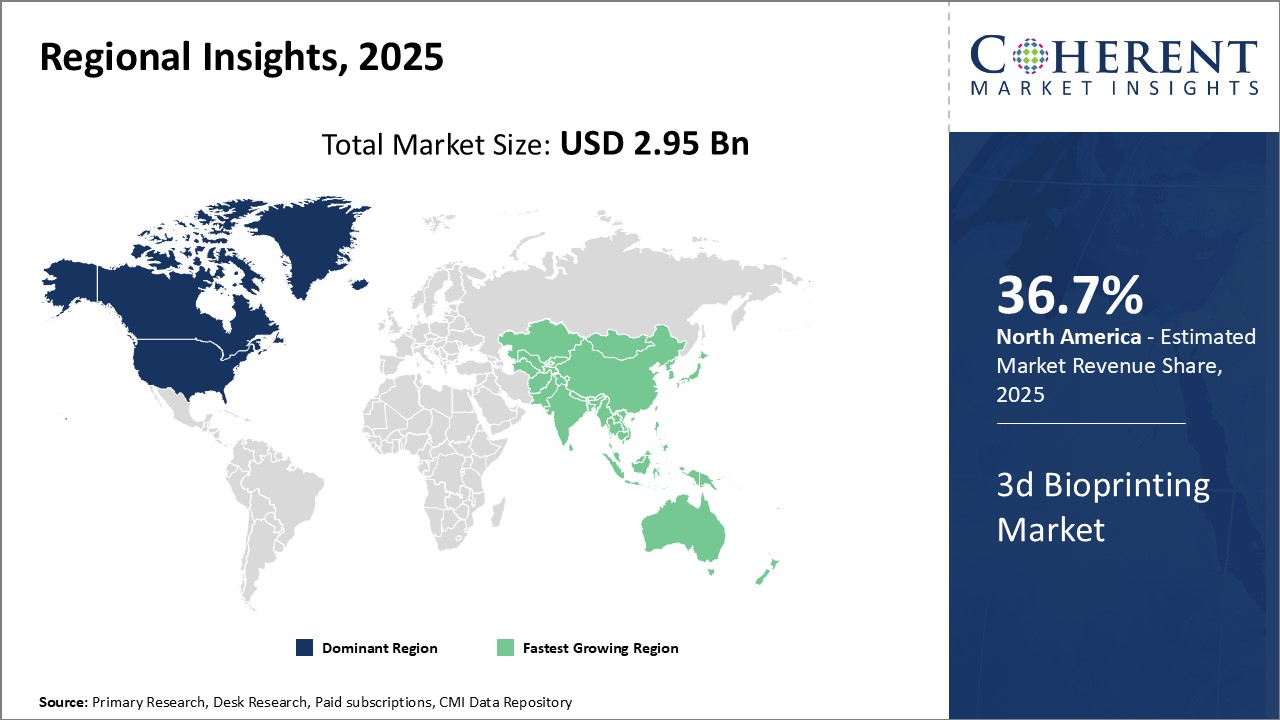
Need a Different Region or Segment? Customize now
North America has strongly established itself as the dominant region in the global 3D bioprinting market and is expected to hold the highest market share of 36.7% in 2025. The presence of prominent industry players and research organizations has propelled technological advancements in the field over the past decade. The U.S. accounts for the bulk of the regional market share due to extensive funding for R&D activities from both public and private sources. Coupled with a favorable regulatory environment and healthcare infrastructure conducive to translation of innovations, North America has been able to maintain its first-mover advantage. The region also attracts global talent and experts working toward the development of advanced bioprinting platforms and applications. Aided by high disposable incomes, North America has evolved as an early adopter of bioprinted products as and when they receive approvals and enter commercialization.
The Asia Pacific region has emerged as the fastest growing market for 3D bioprinting globally and is expected to grow further with the CAGR of 19.98% in 2025. Countries like China, Japan, India, and South Korea have committed substantial investments toward the development of their healthcare sectors with a focus on next-gen technologies. This has created a lucrative environment for market players to establish manufacturing and testing facilities while also driving significant indigenous R&D activities. The availability of a large patient pool and lower operating costs compared to mature regions further aid clinical trials and validation of novel solutions. The large and rapidly expanding medical device and pharmaceutical industries in Asia Pacific have started utilizing bioprinting for development of personalized treatments. In addition, the rising medical tourism across Asia Pacific is enabling greater awareness and acceptance of bioprinted products. With supportive policies and initiatives, the region is well positioned to gain global dominance in this sector over the coming years.
3D Bioprinting Market Report Coverage
| Report Coverage | Details | ||
|---|---|---|---|
| Base Year: | 2024 | Market Size in 2025: | USD 2.95 Bn |
| Historical Data for: | 2020 To 2024 | Forecast Period: | 2025 To 2032 |
| Forecast Period 2025 to 2032 CAGR: | 16.4% | 2032 Value Projection: | USD 8.53 Bn |
| Geographies covered: |
|
||
| Segments covered: |
|
||
| Companies covered: |
3D Bioprinting Solutions, Advanced Solutions Life Sciences, LLC, Allevi Inc., Aspect Biosystems Ltd., Bico group ab, Bio3D Technologies Pte. Ltd., Cellink Global, Collplant Biotechnologies Ltd., Cyfuse Biomedical K.K., Electro Optical Systems, Envisiontec GmbH, Foldink Life Science Technologies, Formlabs, Inc., GE Healthcare, Inventia Life Science PTY LTD, Nano 3D Biosciences, Inc., Optomec Inc., Organovo Holdings, Inc., Pandorum Technologies pvt. ltd., Precise Bio, Regemat 3D S.L., Regenovo Biotechnology Co. Ltd., Renishaw plc., Revotek co., ltd., Rokit Healthcare, inc., Stratasys Ltd.Vivax Bio, LLC, and Vivax Bio, LLC |
||
| Growth Drivers: |
|
||
| Restraints & Challenges: |
|
||
Uncover macros and micros vetted on 75+ parameters: Get instant access to report
*Definition:
"The 3D bioprinting market involves the use of 3D printing technologies to print biological materials and living cells layer-by-layer to build complex 3D biological structures and functional tissues that mimic natural tissue. Key applications of 3D bioprinting include developing tissue and organ transplants without donors, manufacturing of artificial skin and bone for testing cosmetic and pharmaceutical products, and building microenvironments to study cell-cell and cell-extracellular matrix interactions for drug development and disease models."
Share
Share
About Author
Monica Shevgan has 9+ years of experience in market research and business consulting driving client-centric product delivery of the Information and Communication Technology (ICT) team, enhancing client experiences, and shaping business strategy for optimal outcomes. Passionate about client success.
Missing comfort of reading report in your local language? Find your preferred language :
Transform your Strategy with Exclusive Trending Reports :
Frequently Asked Questions
Joining thousands of companies around the world committed to making the Excellent Business Solutions.
View All Our Clients
US Reciprocal Tax Impact Analysis On 3d Bioprinting Market
Stay updated on tariff changes with expert insights and timely information